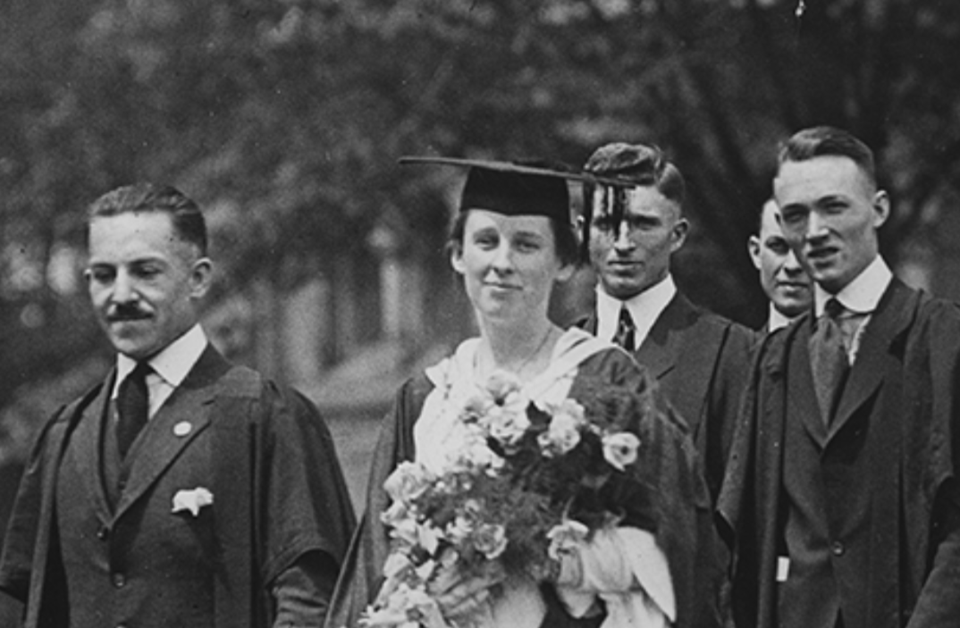Guelph has been the birthplace or sometime-home of many women who have made great accomplishments in a wide variety of fields. Some, like film star Neve Campbell and fashion designer Lucy, Lady Duff-Gordon, achieved celebrity status.
Others are not as well known, though they are certainly deserving of recognition. One was Esther Marjorie Hill. Perhaps her chosen profession in architecture was not as glamorous as that of a Hollywood star or an internationally acclaimed designer of clothing for the rich and famous, but she made her mark in a domain that in her day was considered closed to women.
Marjorie (the name she preferred) was born in Guelph on May 29, 1895, the only child of Ethelbert Lincoln Hill and his wife Jennie (nee Stork). They resided on Glasgow Street., but later moved to Sydenham Street.
Marjorie was born into an academic environment. Both her parents were teachers. Ethelbert was the “science master” at the Guelph Collegiate Institute. Jennie was a trail blazer in women’s education. She had been one of the nine female students who attended the University of Toronto in 1884, the first year that institution had allowed women to enrol. She taught mathematics at Moulton Ladies College in Toronto before moving to Guelph.
Marjorie first attended school in Guelph, but then in 1907 the family moved to Calgary when Ethelbert accepted a position as science master at a high school there. During the few years the Hill family resided in Calgary, Ethelbert helped establish a public library. That earned him a position as chief
librarian of the Edmonton Public Library.
Marjorie attended Strathcona High School in Edmonton. Upon graduation, Marjorie enrolled in the University of Alberta. She was the first female student
to be admitted to a program in architecture offered by the Department of Applied Science. Her parents supported her choice, but she faced opposition in what was a male-dominated field.
Cecil Burgess, a prominent Canadian architect who was head of the university’s school of architecture, opposed Marjorie’s admittance. However, his objections didn’t prevent her enrolment.
In 1918, the department was temporarily discontinued due to the First World War, so Marjorie transferred to the University of Toronto. She was one of only two female students doing architectural studies, the only woman to receive a Bachelor’s degree in the Applied Science of Architecture in the graduating class of 1920 and the first woman in Canada to graduate in architecture.
The head of the department, C.H.C. Wright, refused to attend the convocation.
Marjorie did post-graduate studies in architecture and town-planning at the U of T and at Columbia University in New York. In spite of her degrees, she had difficulty finding work in her chosen profession because architectural firms were reluctant to hire a woman.
For a while she was employed as an interior designer in the decorative department of the Eaton Company in Toronto. Then she returned to Alberta and applied to the Alberta Association of Architects (AAA), hoping to find professional work in that province. The AAA rejected her application, and she spent a year teaching in a rural school.
Marjorie’s father may have been influential in helping her get work designing Edmonton’s downtown public library. She went to New York again to work with architects Anna Schenck and Marcia Mead. They had been successful in bringing a feminist approach to architecture there. They specialized
in housing design.
With the experience she’d gained in New York, Marjorie went back and applied to the AAA. This time she was accepted, but only because of an amendment to the provincial Architects Act that required it to admit “any graduate of any school of architecture in His Majesty’s Dominion.” Thus, in 1925, the woman from Guelph became the first registered female architect in Canada.
Nonetheless, in order to get work Marjorie had to move back to New York where she was offered a position in the architectural firm of Katherine C. Budd.
During the Great Depression, when architectural work was scarce, Marjorie supplemented her income by weaving, making gloves and producing greeting cards on a hand press. She won awards as a handicrafts artist, including a first prize at the Canadian National Exhibition in Toronto.
Not until after the Second World War did her career as an architect really begin to blossom.
During the war Marjorie had moved to Victoria, where her parents were living in retirement. In 1940 she received her first independent commission, converting a single-dwelling house into a duplex.
She began to get regular work, designing new houses and converting old ones. She was particularly busy with plans for housing for returning veterans. Her work earned her a commendation from the Veterans’ Land Administration office in Victoria.
Marjorie went to work for the Victoria Town Planning Committee, the first woman to hold that post. She also joined the Architectural Institute of British Columbia (AIBC). She made a significant contribution to the architectural development of Victoria.
Among Marjorie’s architectural designs were those for apartment buildings in which she displayed the influence of European modernism. Her colleagues said she embraced an architectural style that had “social sensibility” and brought to design a practicality that “extolled the virtues of sun, light, air and space.”
Marjorie Hill lived in Victoria for almost 50 years, designing houses, apartment buildings and public buildings until poor health forced her to retire. She died on Jan. 7, 1985, at the age of 89.
Unfortunately, in her lifetime she did not receive the recognition that was her due. Credit for her designs sometimes went to male colleagues. Architectural historian Annmarie Adams wrote, “This pattern reiterates in architectural terms what women in many other male-dominated professions have long noted – that their work is wrongly perceived as only realizing ideas generated by men.”
In this column, Then and Now recognizes the achievements of this Guelph-born pioneer.



